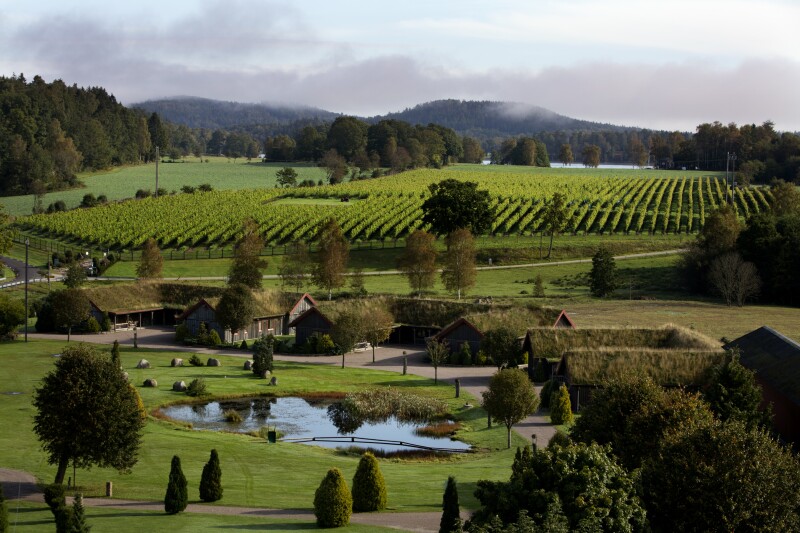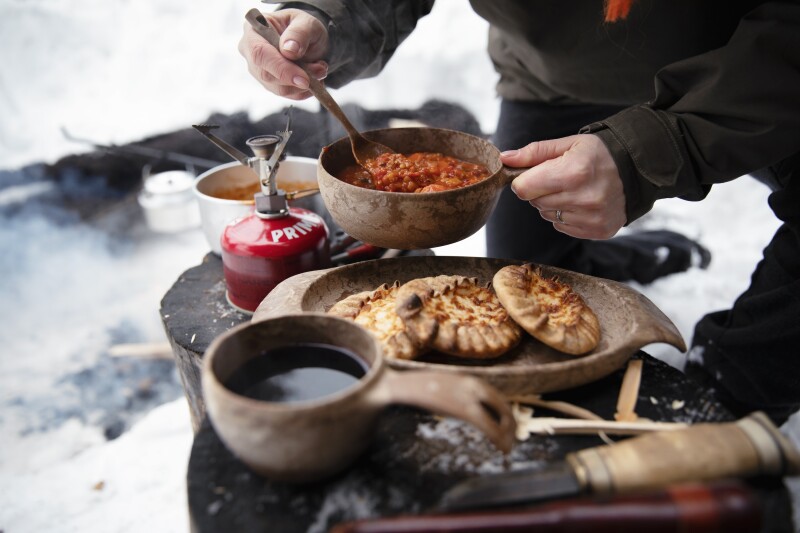The Nordic countries have a rich shared history. But each also has a distinct culture that beckons soul-searchers and adventurers alike to get off the beaten path and immerse themselves in local traditions, discovering the landscapes and experiences outside of the bustling capitals.
Breathe deeply and revive yourself with Norway’s fresh mountain air, exploring pristine glaciers and towering fjords. In Denmark, travel back in time to a world where half-timbered houses and cobblestone streets bring storybooks to life. Relaxation and rejuvenation await in Finland, the “sauna capital of the world.” Enjoy Sweden’s “grape escapes” in the wine region that’s only recently getting the recognition it deserves. Here are some of the Nordic countries’ lesser-known treasures.
See Hans Christian Andersen’s Denmark
Denmark has more than 400 islands, but Funen—also called Fyn (“Foon”) by the Danes—is one of the most enchanting. Here, thatched farmhouses, serene beaches, forests, and grasslands are a 1.5-hour train ride from Copenhagen. Known as “Denmark’s Garden Island,” Funen features more than 120 castles and manor houses framed by richly varied flora.
Among the most grand is Egeskov Castle, where dahlias, roses, and fuchsias are as much a feast for the eyes as the nose. It’s easy to see how the Renaissance-era spires, knight’s hall, and moat might have played muse to Hans Christian Andersen, author of The Snow Queen and The Little Mermaid.
The main town of Funen, Odense, was his hometown and to wander here is to visit the past. You can follow a cobblestone lane to the tiny yellow house where Andersen spent his childhood or stroll through the atmospheric H.C. Andersen Fairy Tale Garden. Sculptures inspired by his stories dot the grounds and a wooden staircase invites you to unplug and watch the ducks float by on the Odense River.
Check out art and design in Aalborg
Art and architecture fans won’t want to miss Aalborg, a juxtaposition of northern Denmark’s rich history and futurist design. Along the intimate streets of Old Town, flowered trellises climb vibrantly colored walls of 17th-century homes accessed via cobblestone streets.
It’s also the birthplace of Jørn Utzon, architect of the Sydney Opera House, who designed Aalborg’s Music House and Utzon Centre with facades that function as urban sculptures. Envisioned as an experience, Utzon Center is more than a museum of Nordic architecture, featuring separate pavilions that surround a center courtyard and shelter guests from the adjacent waterfront’s winds.
Another building that’s a masterpiece itself is the Kunsten Museum of Modern Art. Celebrated Finnish architect Alvar Aalto designed the marble and glass facade rising from the surrounding green forest. Inside, parabola-shaped skylights, lobbies, and galleries showcase contemporary Nordic and international works that the design cleverly protects from yet still illuminates with the sun, giving the impression that traditional barriers between indoors and out have been broken. With the sun’s changing rays, no experience is the same twice.
Taste wine in historic Sweden

Ästad is just one of Sweden’s 30 vineyards where varietals include whites, rosés, and pinot noir.
Courtesy of Visit Sweden//Jerker Andersson
For more casual wine fans and oenophiles alike, check out the undiscovered art of Swedish viniculture. Ferry connections from North Denmark make exploring southern Sweden (or Norway) easy.
The same climate that gives Sweden’s Skåne region the reputation as the country’s breadbasket makes for ideal grape-growing conditions. Here, you can sip whites, reds, and rosés produced from some 22,000 vines at Hällåkra Vineyard. Enjoy unfussy local fare like cheese and charcuterie boards at picnic tables—it’s not unusual to see visitors in hiking boots and t-shirts.
At Arilds Vineyard, you can even go glamping among the vines. For more traditional accommodations, head to Ästad Vineyard in Halland. The property has the Michelin-starred Restaurant ÄNG, a spa with an underwater wood-fired sauna, and guestrooms and villas with copious windows that highlight the tranquility of the surrounding beech forest.
Swim in Luleå
For a beach experience, Luleå has several swimming areas within walking distance of the city center, as well as hiking trails like those around the Hertsöträsk area. Exploring on foot is a journey through history, and hikers can traverse what was once a seabed or Bälingeberget mountain, where the Ice Age shaped the rocks forming a distinctive summit.
Stone has played a vital role here since the dawn of time. A 15th-century stone church surrounded by red wooden cottages anchors the church town of Gammelstad, once Luleå’s capital. It’s Scandinavia’s best-preserved example of infrastructure built to temporarily host distant worshippers who until the 1950s traveled here in difficult weather conditions. Gammelstad today is a living museum and a UNESCO World Heritage Site.
Hike the legendary landscapes of Helgeland

The vibrant waters and sandy beaches of Helgeland in northern Norway
Courtesy of Visit Norway//Terje Rakke
If you’re a UNESCO enthusiast or outdoorsy, then you won’t want to miss Norway’s Helgeland Coast, and the Vega Archipelago within it, each a UNESCO-designated site. The route that hugs the coast of Helgeland is one of the world’s most beautiful drives. The midnight sun offers endless summer days and in winter you have a chance to marvel at the northern lights.
Helgeland’s landscapes are legendary. To experience nature here is to learn the tales Norwegians have passed down through millennia of generations. The mountaintops, known as the Seven Sisters, are a collection of peaks said to be troll maidens turned to stone by the sun after disobeying their father. The proximity of the Sisters means that a skilled hiker can ascend them in one day.

Torghatten is one of the most popular hikes along the Helgeland Coast.
Courtesy of Visit Norway/Sven-Erik Knoff
The mountain of Torghatten is renowned for the hole that runs through its center, allowing the sun to peek through. Legend has it that the void is the hat of a king that froze to stone. The walk to it is much easier than ascending the Seven Sisters and 30 minutes of beginner-level climbing yields stunning views across the Helgeland Coast. Plus, the trails of the Vega Archipelago are a paradise for cyclists, and kayakers and anglers delight in the waters of the sheltered islets.
Eat farm-fresh food in Røros
The wintry climate of Røros fueled another generation of storytellers and visitors can discover the 18th-century wooden homes that helped inspire Disney’s Frozen. The town, a UNESCO World Heritage Site, is well-known among Norwegians for its enchanting Christmas Market when snow blankets the timbered stalls lining intimate streets and reindeer are ready for sleigh rides. These enchanting beasts are wild and tame in the region, and you can go for a ride throughout winter before tucking into a hearty meal.
Røros is Norway’s local- and slow-food capital. The cool climate and long summer nights lend the cheeses and farm-fresh produce distinctive flavors and sampling wild game, fish, or a soul-satisfying soup at family-owned restaurants like Kaffestuggu provide sustenance and a cultural perspective.
Dishes enjoyed here today reflect what the Indigenous Sami tribes have foraged and hunted for centuries while living in their distinctive lavvo turf huts. You can tour one within walking distance of Røros’ center.
The region of Telemark is a study in contrasts. Here you’ll find idyllic coastlines and rugged mountains for adventure (bungee jumping, climbing, and biking abound); farm-fresh fare plated in resplendent settings; and everything from tucked-away mountain cottages with few bells and whistles to bellboys at the historic Dalen Hotel. The fairytale-like yellow façade of the Dalen pops against the surrounding verdant mountains and it’s easy to imagine the four kings that have stayed here while gazing at the wooden dragon heads, towers, cornices, and balconies before savoring a five-course dinner with wine.
For a wellness experience on the water, try the Soria Moria Sauna. Modern and dreamlike, the building’s peaked silhouette features wooden shingles, in homage to the region’s building techniques, interspersed with golden shingles. They glimmer like the scales of fish in the water that the sauna sits seemingly suspended over.
Finland’s saunas

Karelian pasties delight those visiting Finland.
Courtesy of Visit Karelia/Harri Tarvainen
Those seeking restorative travel should put Finnish sauna culture at the top of their “must-do” list. The country has a population of 5.6 million people but more than 3 million saunas—the national art of relaxation is part of UNESCO’s World Heritage list.
The historic city of Tampere has 60 public saunas, the most in the country, with options including rooftop rituals, floating saunas, and restaurant spas such as Kuuma that enhance the social and communal aspects of the practice with a living room-like atmosphere. One of the most charming saunas is also one of the most historic. Rajaportti is Finland’s oldest operating public sauna and not much has changed since 1906. At its heart is a massive woodburning stove to heat stones that glow and spark. New guests quickly learn a word that’s integral to Finns: löyly, the steam that arises from water thrown onto the hot stones.
Another favorite nearby Tampere in Mänttä is Serlachius Museum’s new Art Sauna. The architectural masterwork is a contemporary journey of light, nature, and creative inspiration that marries the work of Finland’s most respected painters and designers via concrete and stone, and oak and aspen.
Within larger cities, there’s respite as well. Helsinki’s traditional Lonna Sauna, built solely with natural materials, is easy to access via public transportation from the city center, as is the newer Löyly sauna. At Löyly, try wood-burning and smoke saunas before taking a refreshing plunge into the sea, as Finns do. The café and expansive outdoor patio are favorites to satisfy an appetite after you’ve soothed your soul.
Turku’s fine and traditional foods
Finland’s original capital of Turku awaits epicureans who want to get a taste of history and some of the country’s finest cuisine. Like all great trading gateways, international flavors commingle with what’s fresh and local. Turku is home to the world’s largest archipelago, so fish here is plentiful and Finland’s finest agricultural lands surround the city. You’ll find duck, elk, and venison at restaurants like Kaskis (where chef Erik Mansikka earned Finland’s first Michelin star outside Helsinki).
For a more casual experience, don’t miss Karelian pasties. The rye pockets filled with rice porridge or barley are ubiquitous throughout the region. Topped with salted butter, they all pair savory and sweet, a glorious study in contrasts like the most satisfying adventures.












